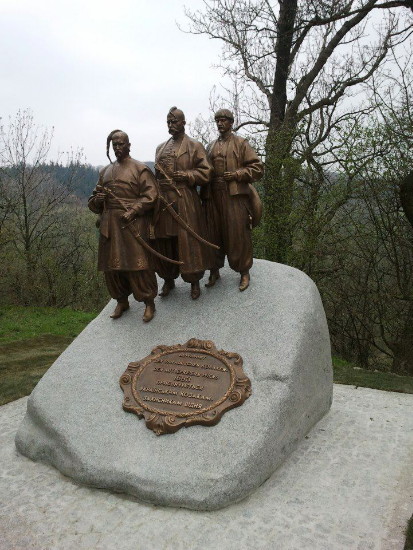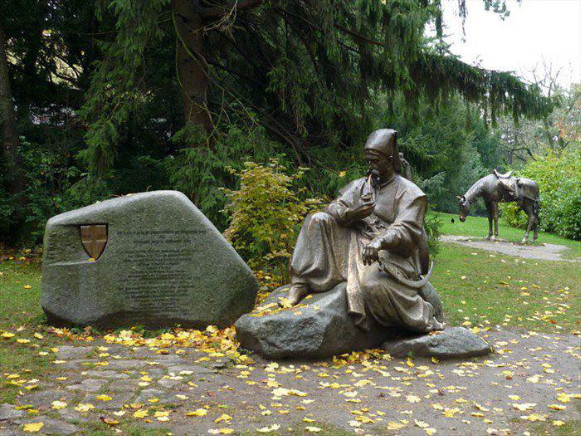Vienna
Vienna (German: Wien). The capital of Austria (2012 pop 1,757,353), situated on the Danube River. It is a national and international political center with a vibrant cultural history.
Before 1772 Ukrainian contact with the city was sporadic. Trade relations with Ukraine had existed since the Princely era. Ukrainians (notably the Transcarpathian polemicist Mykhailo Andrella) had studied at the University of Vienna since the 16th century and Pavlo Rusyn published his collection of Latin verse there in 1509. In 1683 Yurii Frants Kulchytsky was instrumental in lifting the Turkish siege of the city, while Hetman Stepan Kunytsky led a Cossack force into battle against the Turks on its outskirts. Kulchytsky later founded Vienna's first coffeehouse, had a street named after him, and had a monument erected in his honor in 1885.
With the Austrian annexation of Galicia (1772) and Bukovyna (1774) Ukrainian ties with the city increased substantially. Vienna served as a training ground for Ukrainian parliamentarians and civil servants as well as for the Ukrainian Greek Catholic clergy. In 1774 Empress Maria Theresa and Emperor Joseph II established an ‘Oriental Academy’ that was to serve as a school for Eastern rite clergymen. This was the first Barbareum. It had trained many theological and lay scholars by the time it was supplanted by the Greek Catholic Theological Seminary in Lviv in 1784. That same year Saint Barbara's Church was organized as a Ukrainian Catholic parish; it soon became a center of Ukrainian community life in Vienna. A crown boarding school where lay students of various nationalities and Ukrainian candidates for the clergy stayed and studied together was established in the city in 1804. When it was closed in 1847, 30 Ukrainians were living there. The facilities subsequently housed the Central Theological Greek Catholic Seminary (the so-called Second Barbareum), which was attended by an average of 50 students annually until its liquidation in 1892.
The Ukrainian community in Vienna consisted of government officials, among them figures such as Antin Dolnytsky, O. Haninchak, M. Harasymovych, I. Kopystiansky, O. and Ye. Lopushansky, T. Luchakivsky, V. Mykhalsky, Yuliian Romanchuk, I. Savytsky, Aital Vitoshynsky and I. Vitoshynsky, Yu. Vyslobotsky, and Roman Zalozetsky-Sas; general laborers who were permanent residents; students and military personnel who were temporarily in the city; various politicians (including members of the Austrian parliament) and journalists; and those who came to local sanatoriums. There were also some emigrants (such as Andrii Rozumovsky) from Russian-ruled Ukraine. At the outbreak of the First World War there were 3,000 Ukrainians living in Vienna. Before 1914 Vienna University (particularly the Slavists Franz Miklosich and Vatroslav Jagić) trained a number of Ukrainian scholars, including Ivan Franko, Omelian Ohonovsky, Mykhailo Osadtsa, and Stepan Smal-Stotsky. Other notable graduates were the optometrist M. Borysykevych, the urologist T. Hrynchak, the chemist Ivan Ya. Horbachevsky, and the physicist Ivan Puliui.
The number of Ukrainian students in the city increased consistently over the years. In 1868 they established the Sich student society of Vienna, the oldest Ukrainian students' society. Roman Sembratovych established the monthly X-Strahlen in 1900 and then joined with Vasyl Yavorsky to edit Ruthenische Revue (1903–5), which was later renamed Ukrainische Rundschau (1905–14). Yaroslav Vesolovsky, a former editor of Dilo, worked as the Ukrainian and Russian press commissioner for the Austrian Ministry of Foreign Affairs. Community organizations included the student Sich, the workers' society Rodyna, the Saint Barbara's Brotherhood, the Zemliaky society, and the Ukrainska Besida society.
After the outbreak of the First World War the number of Ukrainians in Vienna increased to 15,000 because of the Russian occupation of Galicia and Bukovyna. The city briefly served at this time as a virtual capital of Ukrainian political and cultural life. The Supreme Ukrainian Council (established in 1914, renamed the General Ukrainian Council on 5 May 1915), the Union for the Liberation of Ukraine, the Military Executive of the Ukrainian Sich Riflemen, the Ukrainian Parliamentary Representation, and the editorial offices of countless transplanted Ukrainian newspapers from Galicia and Bukovyna were all active in the city. New periodicals were established (published in Ukrainian and German), including Vistnyk Soiuza vyzvolennia Ukraïny, Ukrainische Nachrichten, and Ukrainische Korrespondenz. New organizations included the Ukrainian Cultural Council, the Ukrainian Relief Committee, and the Ukrainian Women's Union.
After the signing of the Peace Treaty of Brest-Litovsk the government of the Ukrainian National Republic maintained an embassy in Vienna (staffed by Hryhorii Sydorenko and Andrii Yakovliv), as did the Hetman government (Viacheslav Lypynsky was ambassador) and the Western Ukrainian National Republic (ZUNR; represented by Volodymyr Singalevych and Mykola Vasylko). H. Besidovsky and Yurii Kotsiubynsky served as consular officials for the Soviet Ukrainian republic in Vienna.
After the dissolution of the Austro-Hungarian Empire the Ukrainian population in Vienna dropped briefly, but it rebounded after the arrival of the government of the Western Ukrainian National Republic under Yevhen Petrushevych in late 1919. In 1920–3 Vienna vied with Prague in importance as a Ukrainian émigré center. New organizations emerged, including Yednist, Postup, the Ukrainian Club, and the Union of Ukrainian Journalists and Writers Abroad. The Ukrainian Free University and the Ukrainian Sociological Institute were established initially in Vienna, in 1919–21 (both later moved to Prague). About 400 students attended various Viennese institutions of higher education in this period. The headquarters of many political parties also moved to Vienna and published various periodicals, including Ukraïns’kyi prapor (the organ of ZUNR), Boritesia – Poborete (the organ of Mykhailo Hrushevsky's Ukrainian Party of Socialist Revolutionaries), Semen Vityk's Sovietophile Nova hromada (Vienna), Volodymyr Vynnychenko's Nova doba (Vienna), Vasyl Vyshyvany's Soborna Ukraïna, Na perelomi (edited by Oleksander Oles), and the nonpartisan Volia (Vienna) (published by Viktor Pisniachevsky). Viacheslav Lypynsky published his series Khliborobs’ka Ukraïna (Agrarian Ukraine) in Vienna, and T. Savula opened his bookstore in the city. The publishing houses Dzvin, Dniprosoiuz, Zemlia, Chaika, the Vernyhora publishing house, and other publishers issued numerous titles, ranging from textbooks to fiction. Most of these were banned from distribution in Ukraine.
After the Polish annexation of Galicia in 1923, much of the Western Ukrainian emigration moved back to Galicia. The result was the closure of many Ukrainian presses and publishing houses and most community organizations in Vienna. The number of Ukrainians in the city declined to 3,000 or 4,000, mainly workers, pensioners, and lesser civil servants, and some professionals. Ukrainian community life continued in the form of various jubilees, civic meetings, and demonstrations. The last included assemblies and actions against the Pacification in 1930, against religious persecution in the USSR, and against the Famine-Genocide of 1932–3 in Ukraine in 1933 (Cardinal Theodor Innitzer, the archbishop of Vienna, led a multidenominational and international committee formed to provide relief for its victims). In 1929 the Congress of Ukrainian Nationalists was held in Vienna, at which the Organization of Ukrainian Nationalists (OUN) was formed. The writer Ostap Hrytsai worked in Vienna in 1914–45.
After the annexation of Austria by Germany in 1938, the Nazi authorities abolished the 15 existing Ukrainian organizations and societies. In their place branches of the Ukrainian National Alliance and the Ukrainian Institution of Trust in the German Reich were formed.
During the Second World War the number of Ukrainians in the city increased again, particularly after 1944, when a wave of refugees arrived and increasing numbers were conscripted for forced labor (see Ostarbeiter). In 1944 and early 1945 representatives of the Cracow-based Ukrainian Central Committee and the publishing house Ukrainske Vydavnytstvo (Cracow) published Krakivs’ki visti in Vienna. Soviet forces captured the city on 15 April 1945 and immediately began repatriating those citizens who had not managed to flee to the West. Among those deported were Viktor Kurmanovych, S. Naklovych, T. Voloshyn, Wilhelm Habsburg-Lothringen, and Mykola Zalizniak. After the signing of a peace treaty between Austria and the USSR on 15 May 1955, some former residents returned to Vienna following a 10-year period of incarceration.
After 1955 Vienna once again became an émigré center and the headquarters of the Coordinating Council of Ukrainian Organizations of Austria and the Ukrainian Central Relief Alliance in Austria. Other active community organizations included the Ukrainian Women's Union in Austria, the Union of Ukrainian Philatelists, and the Bukovyna society. Individuals active in the immediate postwar period have included S. Bush, M. Ivanovych, Yu. Kostiuk, S. Naklovych, D. Rakhlitsky, Volodymyr R. Zalozetsky-Sas, B. Yaminsky, and I. and O. Zhupnyk. Saint Barbara's Church has a renowned choir conducted by Andrii Hnatyshyn and a church brotherhood led by I. Zhupnyk. According to the parish records of 1989, there are 1,400 Ukrainians living in Vienna. Many of them, particularly the young, have been entirely assimilated. Ukrainian Catholics in the city were served by Rev O. Dzerovych, and the Orthodox by Rev P. Dubytsky.
Many libraries, archives, and museums in Vienna have valuable holdings of materials on Ukraine and Ukrainians, particularly the National Library, which preserves Ukrainian publications of Bukovyna and Galicia from 1772–1918 as well as a large collection of maps.
Myron Hornykevych, Andrii Zhukovsky
[This article was updated in 2013.]
.jpg)
.jpg)


.jpg)
.jpg)